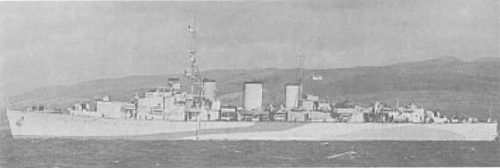- Author
- Dowle, Ron
- Subjects
- Biographies and personal histories, History - WW2
- Tags
-
- RAN Ships
- None noted.
- Publication
- December 2005 edition of the Naval Historical Review (all rights reserved)
(Ron Dowle continues this account of his service in the fast minelayer HMS Ariadne in the Pacific war 1944-45 – Part 1 is in September 2005 Edition of Review)
In September 1944 we were ordered to join Admiral Halsey USN and the US Third Fleet, to prepare for the assault and hopefully the recapture of the Philippines. Our first assignment, as we were carrying no mines, was to steam to Port Moresby, New Guinea and pick up several thousand lifejackets for the assault troops. We had special equipment onboard for measuring (sea) current drift, so we were sent ahead of the Third Fleet, another force was on its way from the Marshall Islands. We arrived in the Gulf of Leyte a full day ahead of the two forces. We were surprised we were not greeted with gunfire, they (Japanese) were obviously waiting for the air force. We did not have long to wait, we were subjected to some very heavy attacks, a couple of sticks of bombs went off close alongside. Their radio was heard to report they had sunk a British cruiser.

Shortly afterwards we heard more gunfire. It was the US Navy planes – the carriers had come within striking distance. The next day, as far as the eye could see, were rows upon rows of landing craft. As they came closer they were unlike anything we had ever seen. Soon we were to see what they were and what they were capable of. They were like barges, with row after row of rocket launchers; nothing I had seen before could describe the effect on the shoreline when the rockets exploded. As one row of barges fired their rockets, another row took their place, and so on. Everything on shore just disappeared, including all the trees and vegetation, but the loss of life (amongst the invading US marines) was still very high, from the reports we received. The Japanese were very well entrenched. Every little hole in the island contained Japanese troops or booby traps.
I had now received my advancement to Petty Officer and in the middle of April 1945 we received orders to return to England as soon as possible. A quick return to Sydney to pick up ammunition, and the furniture we had left ashore (in storage).
The Return Home
The maximum permitted passage speed on the Gatun Lake was too slow for our CO; a couple of huts were washed away on shore, but it was wartime and the Panama Canal was under American control – though we were fined a few thousand dollars.
We arrived in home waters ten days later and were instructed to proceed to Milford Haven in Wales (Milford Haven was the mining port for the minelayers). Here we were to meet our sister ship, HMS Apollo, and for the next two weeks we were working around the clock, laying mines around (neutral) Ireland and its seaward approaches, to prevent German submarines and ships seeking shelter to avoid capture.
VE Day
At the end of April we berthed in the Thames, London Docks. Here we had to embark some VIPs. We had no idea who they would be. They proved to be King Olaf and Norwegian Government members, and we were to take them to Oslo (for the liberation of Norway). One of our petty officers was a great fan of a world-famous piano accordionist before the war, and now we tried to track him down. His name was Toraf Tolafson and he was easier to find than we expected. His father turned out to be a hero with the locals. We were invited to their home and shown through. It turned out to be a miniature arsenal, with bombs, machine guns, explosives and hiding places everywhere. It happened that he was the leader of the underground movement in Oslo. We were informed, over a few drinks with them, that they were hanging a Quisling (Norwegian traitors, named after the leader of the German collaboration government) in the square the next morning.
Our duties kept us onboard in the morning but a few of the lads went to the square that afternoon and the body was still hanging there. We had some wonderful times with these people, about six days in all, then we proceeded for home again. On 8th May 1945 we were still a fair way from our destination when the good news broke. Germany had surrendered. We were headed for the nearest port, Edinburgh.




